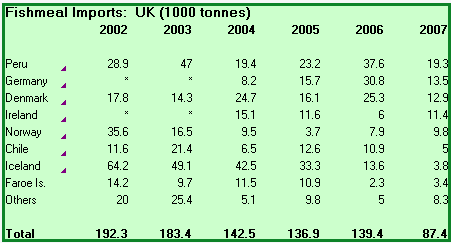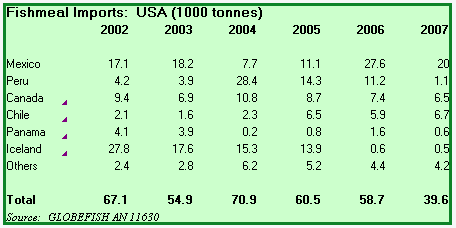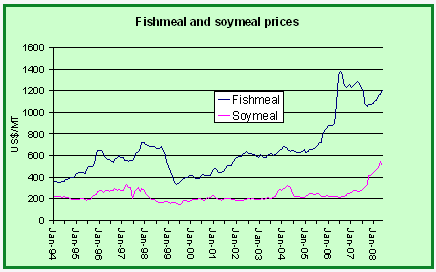Fishmeal prices that had been rather stable in the course of 2007, soared in the course of 2008. In May 2008, they reached US$ 1 210/tonne, some 11% ahead of the price level at the end of 2007, but 6% below the price level one year ago. This price hike is not a surprise in a climate of overall increasing vegetable meal prices. Various factors will have an impact on further price developments: the overall commodity price increases will create an environment of higher prices, on the other hand, demand from the aquaculture industry is declining, as fishmeal is often replaced by other meals in the feed mixture. The impact of the Chinese earthquake on demand for fishmeal has yet to be assessed. The area hit by this disaster is the core of the Chinese pig industry, thus demand for fishmeal is likely to decline in the short term.
Fishmeal production up

April 2008 was an extremely good month for fishmeal production. With more than 2.2 million tonnes of landings, April 2008 was the best fishing month for the main fishmeal exporting countries since May of last year and was twice as large as the previous month (1.0 million tonnes). About 60% of the monthly landings were located in Peru where the first session opened by the government on April 21 in the North/Centre region led to about 1.27 million tonnes landings in the ten days after the opening. Scandinavian countries, on the other hand, reported lower outputs in April 2008.
Peruvian fishmeal exports were 554 000 tonnes in the first four months of 2008, 23% ahead of the same period of 2007. Main markets were China, Germany, Japan and Australia. 79% of the fishmeal was traditional fishmeal, while the remainder consisted of prime fishmeal products.
The International Fishmeal and Fish Oil Organisation (IFFO), which represents the fishmeal and fish oil industry worldwide, is developing a new Code of Responsible Practice (CORP). The Code will enable fishmeal and fish oil producers to show that they are offering traceable, high quality marine products which are manufactured safely using fish from responsibly managed fisheries. Subject to final approval of the Code by the IFFO Board at its annual conference in October this year, producers should be able to enter the audit process early in 2009. The first certifications would then be announced later next year.
Fishmeal prices have firmed up in the course of 2008 after some declines in the second half of 2007. Nevertheless the present price level of US$ 1 210/tonne is about US$ 100/tonne lower than last year’s price. The relative weakness of fishmeal prices in 2007, especially when compared to the booming soymeal prices, was due to little buying interest in China. However, this changed in early 2008.
Fishmeal production in Peru was 1.42 million tonnes in 2007, slightly down from the 1.45 million tonnes produced in 2006, which compares to 1.9 million tonnes in 2005. Reduced production led to lower exports in quantity terms; however, high fishmeal prices kept total earnings from fishmeal stable at US$ 1.2 billion.
Chilean fishmeal production is declining every year, due to lower horse mackerel landings. In 2007, the production was about 10% lower than in 2006. As a result Chilean exports of fishmeal totaled 490 000 tonnes, down from 520 000 tonnes in 2006 and 710 000 tonnes in 2005. As in the case of Peru, however, exports earnings were positive. Total export earnings reached US$ 539 million, 5% ahead of 2006. Therefore, the unit value of Chilean fishmeal exports increased strongly to US$ 1 100, up 11% from 2006 and 63% from 2005.

Imports of fishmeal into the USA and Europe declined in the course of 2007, as traders were unwilling to pay the extremely high prices. It is interesting to note that the USA is now relying on Mexico for fishmeal supply, while Peru and Canada are losing ground. Some 85% of German fishmeal imports are coming from Peru, while European suppliers are decreasing their share. UK imports also declined in 2007 by 50% over 2006, reporting lower shipments from all main supplying countries.


Further fishmeal price increases unlikely
There are three different issues to be taken into account when forecasting fishmeal price developments for the coming months. On the one hand, fishmeal production seems to be strong, especially in South America, which should lead to lower prices. On the other hand, alternative protein sources are still showing soaring prices, which should also influence positively fishmeal prices. The present price level of soymeal is US$ 500/tonne which is almost double the price level of one year ago. There are some indications, however, that also the price hike for soymeal is coming to an end, and prices started to decline somewhat in May 2008. The impact of the dramatic earthquake in China on pig production and thus feed prices is still to be seen, but demand is likely to be strong. Taking all these indications together, it is likely that fishmeal prices will come down slightly in coming months, to a level of US$ 1 100/tonne.
July 2008
